Updated on 2023-05-11
22 views
5min read
The Mac boasts a plethora of impressive functionalities, making it an industry leader. Among them, the Mac recovery mode stands out as a particularly useful feature, allowing users to restore macOS with ease. Furthermore, the mode provides access to various utilities to address common errors that occur on Mac. Nevertheless, what happens when your Mac won’t boot into recovery mode, leaving you unable to restore it? This dilemma poses a significant challenge with no straightforward solution. However, rest assured that we are here to tackle the problem and offer effective remedies. In this article, we are describing how to use Mac recovery mode when it won’t boot or go into recovery mode.
Part 1: How to Enter Mac Recovery Mode?
It's essential to note that the steps to enter recovery mode on a Mac will vary for Intel-based and M1 Macs. Therefore, before we delve into the instructions, let us guide you on how to determine which processor type your Mac has.
For Mac computers that use Apple silicon, the "About This Mac" section will exhibit an element named "Chip," which is then followed by the chip's name.
For Mac computers that are equipped with an Intel processor, the "About This Mac" section shows an item labeled "Processor," and it displays the name of an Intel processor.
How to Enter Recovery Mode on Mac M1/M2?
Here are the steps to enter recovery mode Mac M1/M2:
Step 1: First you need to navigate to the Apple menu and choose "Shut Down" option. Now you need to wait for the Mac M1/M2 to shut down.
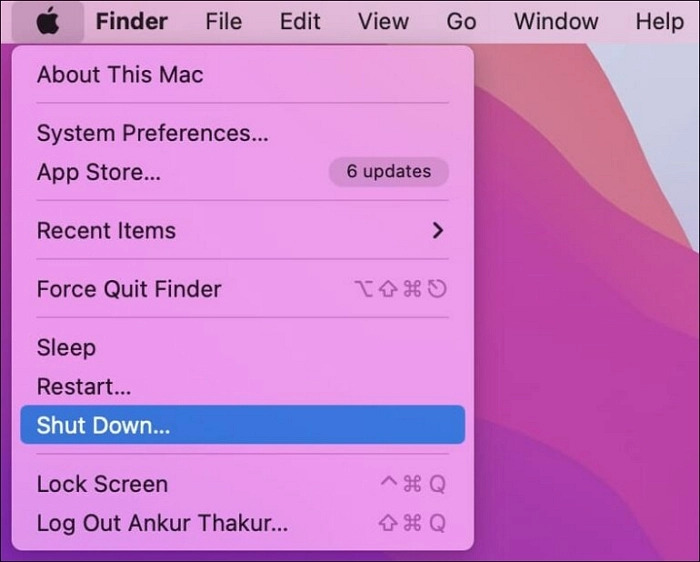
Step 2: Press and hold the Power button, and wait until you observe the message "Loading startup options" on the screen. Select "Options," then choose "Continue."

Step 3: If prompted, pick the volume that you want to recover. Then, click on "Next."
Step 4: Select the administrator account, and then click on "Next."
Step 5: Input the password, and then choose "Continue."
How to Enter Recovery Mode on Intel Mac?
Here are the steps to enter recovery mode on Intel Mac:
Step 1: Click on the Apple logo located on the screen, and then select "Restart" from the dropdown menu.
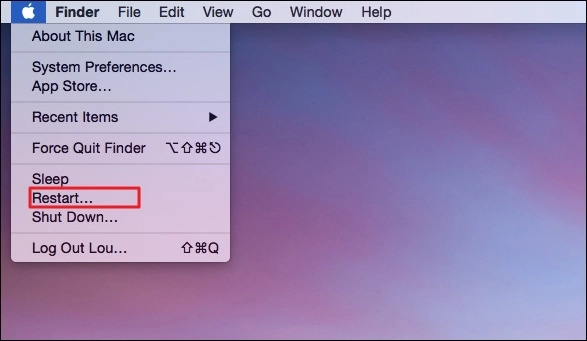
Step 2: To access the macOS Utilities window, simultaneously hold down the Command and R keys until the Apple logo appears. Once the window is open, you can effortlessly repair the disk and reinstall macOS.
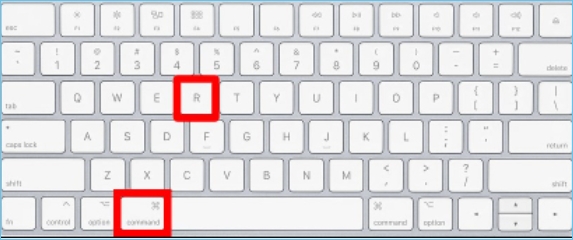
Part 2: What Can I Do in MacOS Recovery Mode?
With the MacOS Recovery Mode, you can resolve MacOS startup problems and reinstall the operating system, resulting in a notable improvement in system efficiency. It's important to note, however, that third-party apps are not accessible in this mode, and there are restrictions on the tasks and apps you can utilize. Let's examine the four distinct functions available in the macOS Utilities window:
Function 1. Restore from Time Machine
If you've utilized Time Machine to create backups of your Mac files, you can select the "Restore from Time Machine" option to retrieve those files. This feature can assist in restoring your Mac to a prior date, potentially retrieving crucial data or resolving update-related issues.
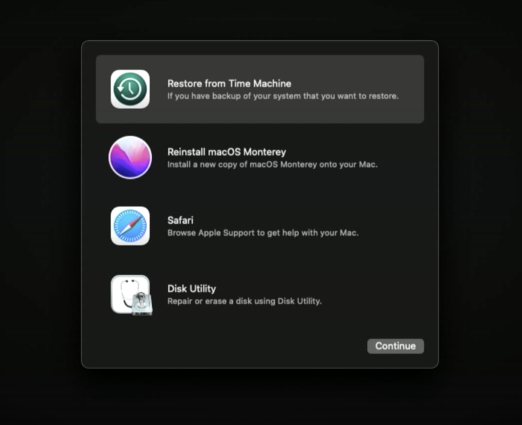
Function 2. How to Use Reinstall macOS Option
The Reinstall macOS function enables you to download and install a clean version of the operating system on your device, which is essential in cases where your device has been severely affected by a virus attack. Upon selecting this option, you will be presented with a thumbnail of the macOS that can be installed on your system.
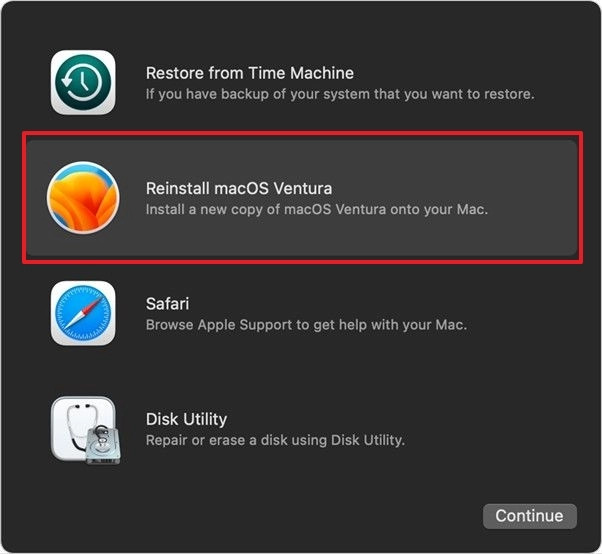
Function 3. How to Use Safari Option
While using Safari, you have the option to seek assistance from Apple support to address a range of issues. However, it's important to note that bookmarks, browser add-ons, and extensions are not supported and you may need to visit various Apple support pages to gather additional information.

Function 4. How to Use the Disk Utility Option
Opting for Disk Utility is the most suitable choice when it comes to repairing or erasing disks on your Mac. With Disk Utility, you can effectively erase or repair your Mac's disk, and even repair external hard drives. You can also format startup disks using the Erase option. Additionally, Disk Utility's First Aid function can be employed to fix any issues.
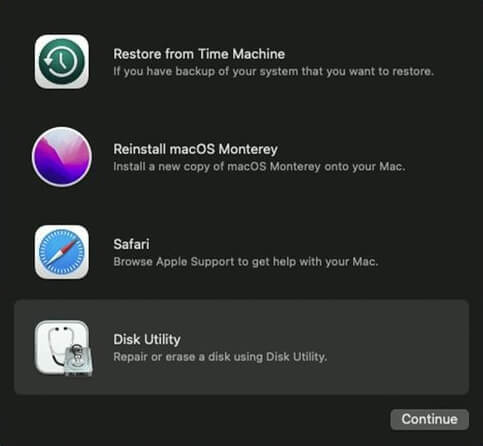
Part 3: Why Do I Need Mac OS Recovery Mode?
For those who may be curious about the necessity of Mac OS Recovery Mode, here's a summary of the reasons behind its importance:
- If you plan to sell your Mac, it's crucial to remove all personal data, including your Apple ID. Utilizing Recovery Mode can be a beneficial resource in accomplishing this task.
- When facing a troubleshooting situation, Recovery Mode is similar to Windows Safe Mode, as it allows you to start your computer with minimal resources. This makes it possible to diagnose and resolve any issues that may be occurring.
- If you encounter an issue with your Mac's hard drive, Recovery Mode can be utilized to access Disk Utility and initiate repairs.
- Recovery Mode simplifies the process of restoring your system from a Time Machine backup.
Part 4: Why Mac Will not Boot or Go into Recovery Mode?
There isn't a singular cause for a MacBook Pro failing to boot or go into recovery mode. Instead, various reasons can contribute to this issue. Some of the most commonly encountered causes include:
- If you are running an outdated version of Mac, such as Snow Leopard, or an even older version, your system likely does not have a recovery partition.
- A damaged or faulty keyboard.
- The Mac is not paired with the Bluetooth keyboard.
- The recovery partition is either absent or corrupted.
- Modern Macs feature diverse methods to access the recovery mode, which can sometimes make it challenging to enter.
The above-given causes are the common causes why your Mac will not boot or go into recovery mode.
Part 5: How to Boot into Recovery Mode Mac If It's Not Working?
After addressing your query regarding the failure of your Mac to boot into recovery mode, let's explore the potential solutions to resolve the issue.
Way 1: Verify the Functionality of your Keyboard
A probable cause for the non-functioning of recovery mode Mac is faulty Command or 'R' buttons. To investigate, you can test these buttons in other applications or utilize an alternate keyboard. If the keys are defective, you can opt to repair them or replace the entire keyboard.
Way 2: Experiment with an Alternative Keyboard Shortcut.
For Macs that feature a T2 security chip, the traditional keyboard shortcut to access recovery mode may be ineffective, resulting in the "Mac can't start recovery mode" issue. In such instances, you must attempt an alternate keyboard shortcut to bypass the problem. If your Mac contains a T2 chip, you may want to make use of this keyboard shortcut: Option/Alt + Command (⌘) + R.
The following Macs are equipped with a T2 chip:
- iMac Pro
- Mac Pro 2019
- Mac mini 2018
- MacBook Air 2018 or newer
- MacBook Pro 2018 or newer
Way 3: Employ a Bootable Installer
If your Mac won’t boot or go into recovery mode, an effective remedy may be to generate a bootable installer and initiate a system restore. Before commencing this solution, ensure that you possess a functional USB device.
Step 1: Access the utility tab on your Mac by navigating to the 'Options' tab upon startup.
Step 2: Choose the 'Disk Utility' option and insert your USB device.
Step 3: Choose the drive from the pop-up list, which will restart the Mac and initiate Mac repair upon startup.
Congratulations! If successful, you have effectively resolved the issue of your Mac's inability to boot or enter recovery mode.
Way 4: Perform an SMC Reset
The System Management Controller (SMC) is a crucial component of Mac's operation as it manages functions such as power, battery, and fans. A glitch in the SMC could account for the failure of your MacBook to boot into recovery mode. Follow the below steps to reset the SMC:
Step 1: Power off your Mac and disconnect all cables.
Step 2: Reconnect the cables and simultaneously press and hold the 'Control-Shift-Option' keys and the Power button for 10 seconds. Subsequently, release all buttons and reboot your Mac to complete the SMC reset process.
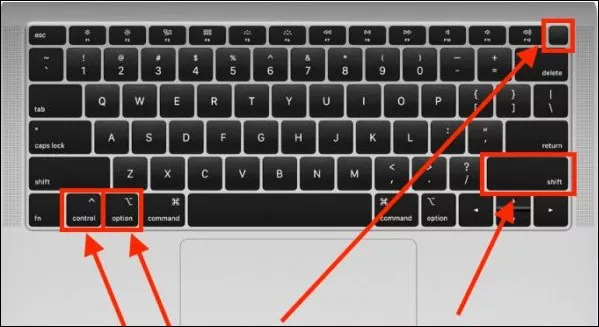
Way 5: Utilize Safe Mode
Safe mode eliminates non-essential features on a Mac, enabling you to identify the underlying cause of the failure to enter recovery mode. To access safe mode on a Mac:
Step 1: Power off your Mac. Until the Startup disks and Options appear on the screen, you need to press and hold the 'Power' button.
Step 2: Subsequently, press and hold the 'Shift' key and select 'Continue in Safe Mode'. After using safe mode, attempt to enter recovery mode.
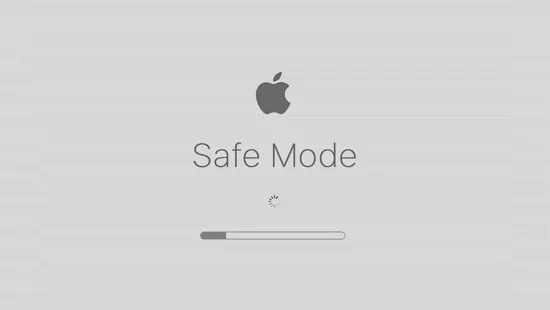
Way 6: Utilize Time Machine Backup
If recovery mode fails to restore your Mac, Time Machine may offer a viable solution. Here's how to use it:
Step 1: Power off your Mac and connect your Time Machine Backup to the device.
Step 2: Press the Power button, and simultaneously hold down the 'Options' key. Release the key once the Startup Manager appears on the screen.
Step 3: Choose the backup drive and select 'Return'. This will take you to the OS X installer window, where you can proceed to restore your Mac from the Time Machine backup.
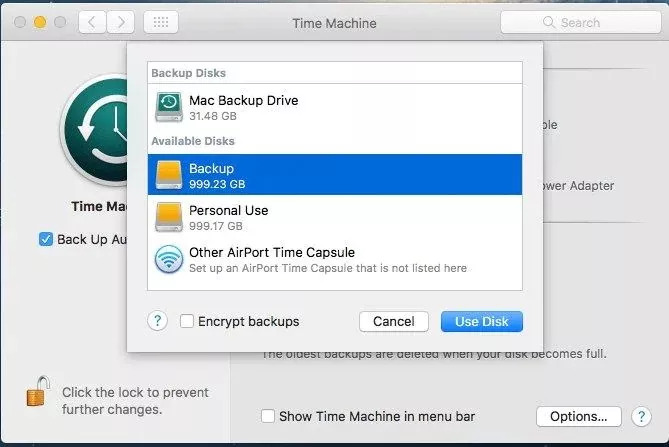
Way 7: Utilize Mac's Internet Recovery Feature to perform a macOS Reinstallation
If you find yourself in a situation where your Mac won't boot into recovery mode, one of the few available options for reinstalling macOS is to use Internet Recovery mode. Here's how to do it:
Step 1: Power off your Mac and then start it up.
Step 2: Once you power on your Mac, hold down the Option + Command + R keys simultaneously until a spinning globe and progress bar appear. Then, release the keys and follow the prompts to reinstall macOS using the Mac Internet Recovery feature.

Part 6: Best Data Recovery Software to Recover Data from Mac
If your Mac fails to boot into recovery mode, it may indicate issues with the recovery partition, which can jeopardize your data. In the worst-case scenario, you might lose your data entirely. In the event of a booting issue, you'll need the assistance of a dependable friend to retrieve your data without difficulty. Eassiy Data Recovery is one of the best recovery software in the market without a doubt. This powerful program can help you to recover lost, deleted, or formatted data files from different storage devices such as hard drives, external hard drives, USB drives, memory cards, and more. By using this tool, you can retrieve data files in various scenarios including accidental deletion, system crash, virus attack, partition loss, etc.
Key Features:
- The software, Eassiy Data Recovery, is designed to be compatible with both Windows and Mac operating systems.
- With this Data Recovery software, you can efficiently filter your search results by file type, size, and date, making it easier to locate the specific files you need.
- The program provides both fast and deep scan modes to ensure that all recoverable files are identified quickly and thoroughly.
- It is possible to retrieve a variety of files such as photos, videos, documents, emails, archives, and more.
- More efficient and successful than other applications currently available in the market.
Steps to recover data from Mac.
Step 1: To initiate the data recovery process, launch Eassiy Data Recovery and choose the data format you wish to restore along with the hard drive you intend to scan. In case you want to retrieve certain file categories, simply tick the corresponding checkboxes.
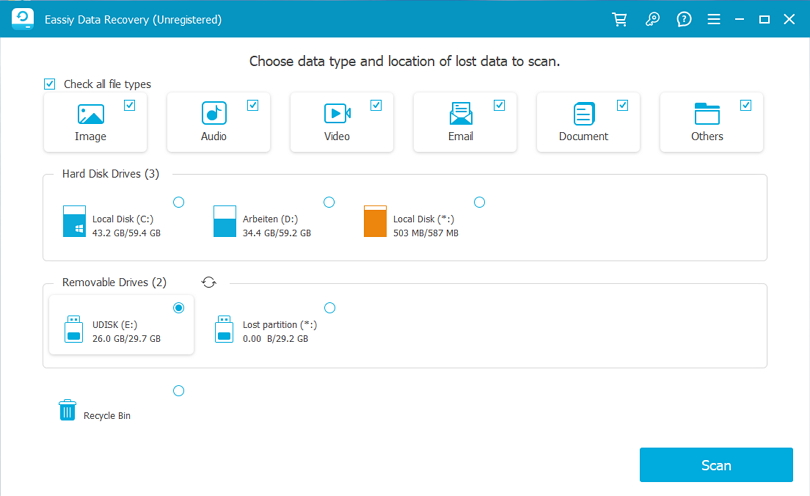
Step 2: Eassiy Data Recovery presents two scanning options: Quick Scan and Deep Scan. Quick Scan initiates automatically upon starting the scanning process and is recommended for recent data loss scenarios. You can examine the scan results by reviewing the files categorized by type and path.
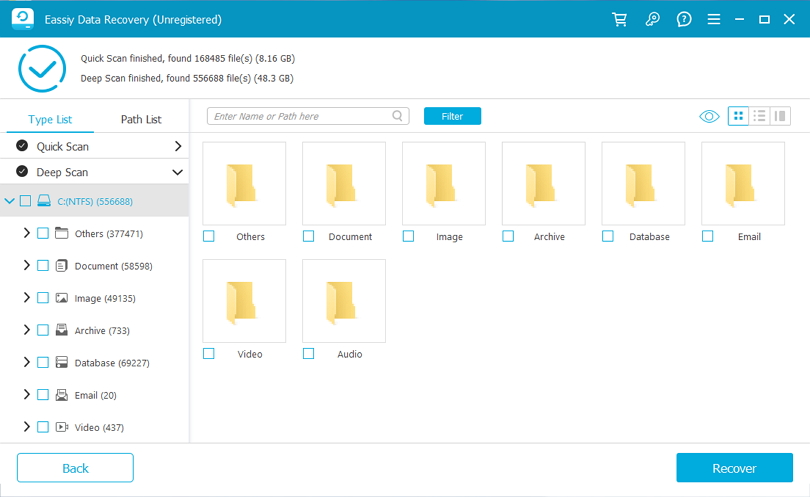
Note: If you are not satisfied with the outcomes, perform a Deep Scan to discover additional content, albeit it may take more time to complete.
Step 3: After all the data categories are displayed, pick the files that require restoration. You can leverage the search bar to locate files by name or path and modify the preview mode by selecting the icons adjacent to the Filter button. Finally, retrieve the chosen files by clicking on the Recover button.
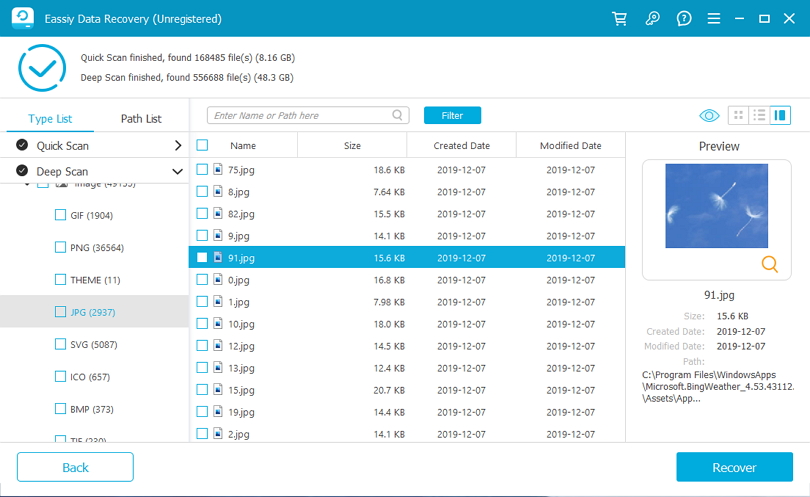
Part 7: FAQ for Mac Recovery Mode
1. Is it possible to reset my Mac to its factory settings without using the recovery mode?
If you are unable to access the recovery mode on your iMac, you can utilize the internet recovery mode to reset your Mac. To proceed, turn off your Mac and press the 'Options + Command + R' keys. Then, follow the subsequent instructions provided by the wizard.
2. What are the steps to exit Recovery Mode?
Frequently, individuals find themselves in Recovery Mode but are unsure of how to exit it. Nonetheless, the process is quite simple.
- To exit the mode, simply select the "Restart" option from the Apple menu.
- In case your Mac persists in returning to the recovery mode, you can employ the Startup Disk feature from the menu. By selecting the regular boot disk and clicking on the Restart button, your Mac will be back to its operational state.
3. What occurs if Recovery Mode fails to function properly?
If the Mac Recovery Mode fails, you may encounter a standard login window, a black screen, or a blank screen instead of the macOS Utilities window. However, you can employ the troubleshooting techniques on nearly all Mac devices.
4. Does using Command + R result in wiping my Mac?
Pressing those keys during a restart will not result in any data loss. It simply initiates the boot process into the Recovery Mode.
Conclusion
There are two reasons why your Mac may fail to boot into Recovery Mode. Firstly, hardware malfunction, such as a broken keyboard, can be a contributing factor. Secondly, there may be an issue with your Mac's recovery partition. In this article, we have described how to use Mac recovery mode when it won’t boot or go into recovery mode. We have compiled a comprehensive list of solutions to address the issue, irrespective of the reason behind your Mac's inability to boot into Recovery Mode. Furthermore, we have equipped you with a potent resolution - the Eassiy Data Recovery tool - to resolve any data loss issues that might arise as a result of this problem.






